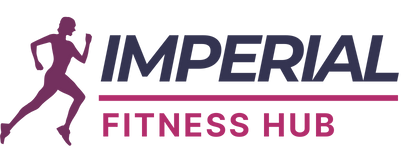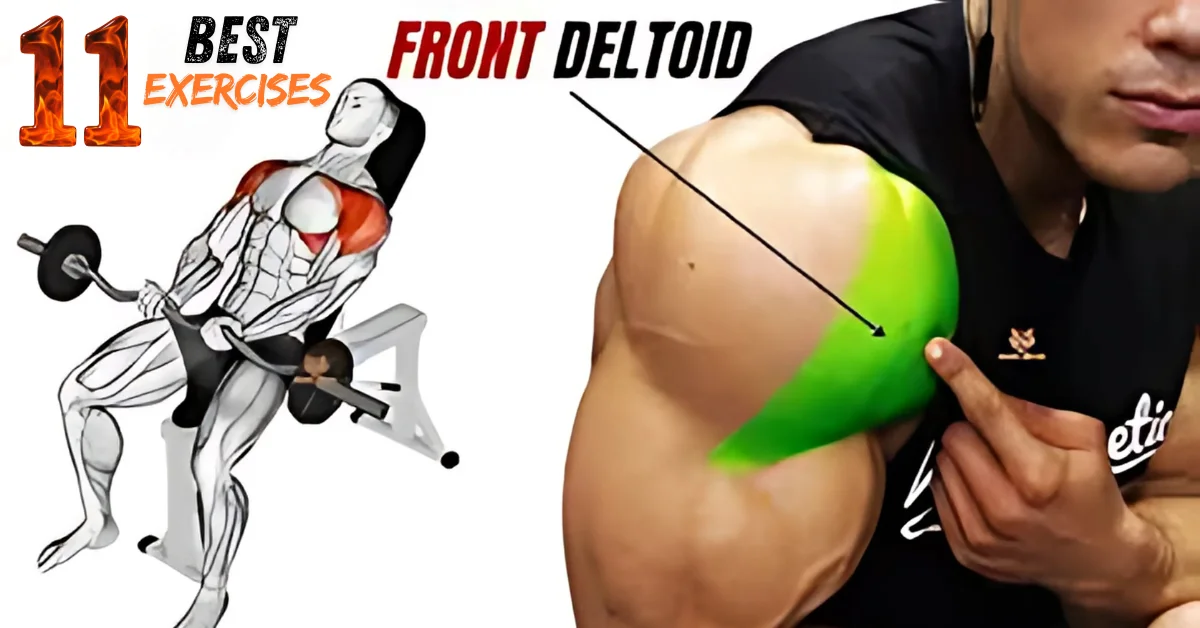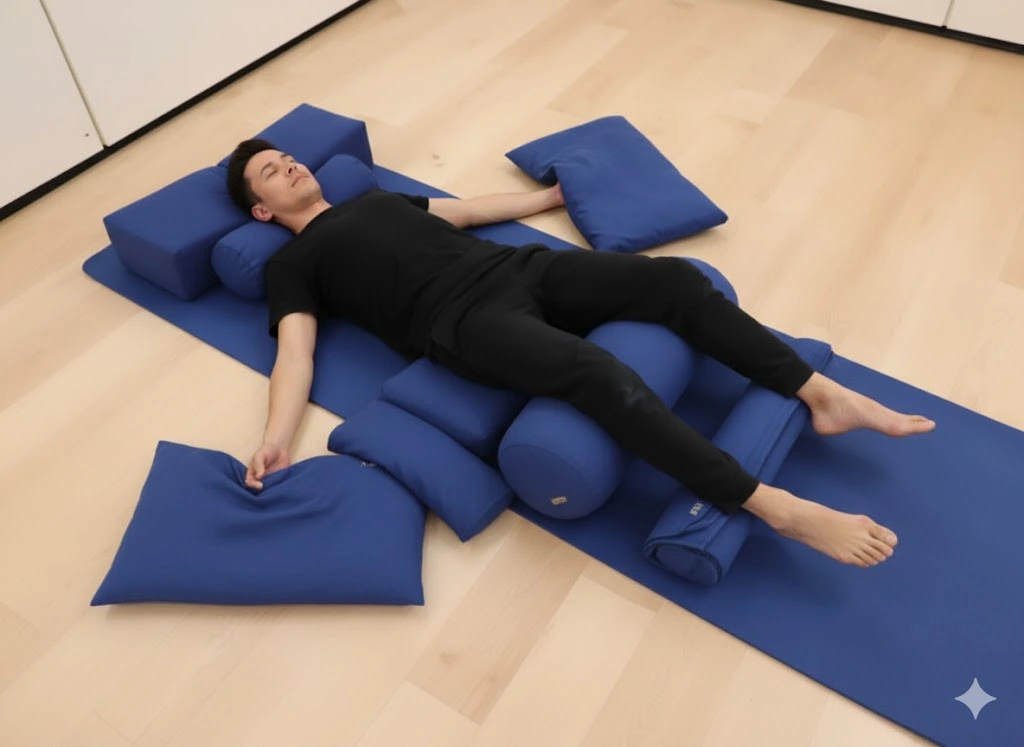Introduction
Strong, well-shaped shoulders are a sign of a powerful upper body. If you’re looking to build impressive delts, focusing on front delt exercises is essential. The front deltoids, also known as anterior delts, play a significant role in almost every pushing movement, whether it is pressing overhead at the gym or lifting a bag of groceries at home. When trained correctly, the front delts add to your shoulder width, improve posture, and help with lifts like the bench press and overhead press. But the key is to choose the best front delt exercises that give you maximum results without wasting time or causing injury.
Many lifters make the mistake of overtraining their chest or skipping their shoulders altogether. This creates muscle imbalance, poor posture, and even shoulder pain. That’s why smart, targeted training for your front deltoid muscles is so important. In this blog, you’ll discover exercises for front delts that are proven to work, easy to follow, and suitable for all fitness levels. We’ll also explore the differences between rear delt exercises, side delt exercises, and front delt moves so you can build full, round shoulders that look great from every angle.
Whether you are training at home or in the gym, using dumbbells, barbells, or cables, these exercises will help you get stronger, prevent injury, and look more athletic. Now that you understand the importance of building your front shoulders, let’s move on to why these exercises matter in the first place.
Table of Contents
Why You Must Train Front Delts
Training your front delts is crucial for overall upper body strength and balanced shoulder development. These muscles assist in all pressing movements, like bench press and overhead press, and are constantly engaged in daily activities.
Strong anterior delts improve pushing power, support heavier lifts, and improve shoulder stability. They also help give your shoulders a full, rounded look from the front, something chest exercises alone can’t achieve. Neglecting front delts can lead to muscle imbalances, poor posture, and shoulder strain. Including front deltoid exercises in your routine reduces injury risk and helps maintain a strong, stable upper body.
Muscles Worked During Front Delt Exercises
Front delt exercises mainly target the anterior deltoid, the front head of the shoulder muscle. This muscle helps raise your arm forward and plays a big role in pushing movements. But these exercises also work other supporting muscles:
- Upper Chest – Especially during incline and overhead pressing moves.
- Side Delts – Often activated as stabilizers during shoulder lifts.
- Triceps – Help extend the arm in pressing exercises.
- Trapezius – Supports shoulder movement and balance.
When performed correctly, these workouts give you more than just stronger front shoulders. They help build a balanced upper body.
11 Best Exercises for Front Delt Growth
Want bigger, stronger front delts? These 11 exercises are the most effective for building your front shoulders, improving pushing power, and enhancing your upper body aesthetics. Whether you are at the gym or training at home, these moves will help you hit your front deltoid muscles from every angle.
Barbell Overhead Press
This classic compound exercise hits the entire shoulder, especially the anterior delts, while also engaging the upper chest and triceps. It is great for building strength and size.
How to Do:
- Lower slowly back to shoulder level and repeat.
- Stand with feet shoulder-width apart.
- Grip the barbell at shoulder level with palms facing forward.
- Press the bar overhead until your arms are fully extended.
Dumbbell Front Raise
A pure isolation move that focuses directly on the front delts. It is excellent for targeting muscle fibers that pressing exercises may miss.
How to Do:
- Pause briefly, then lower them back down slowly.
- Hold a dumbbell in each hand by your sides.
- With a slight bend in your elbows, lift the weights straight in front of you to shoulder height.
Arnold Press
Popularized by Arnold Schwarzenegger, this press targets all three heads of the deltoid, with extra emphasis on the front.
How to Do:
- Reverse the motion back to the starting position.
- Sit on a bench with dumbbells held at shoulder level, palms facing you.
- Rotate your wrists as you press the weights overhead until palms face forward.
Incline Bench Front Raise
This variation increases the stretch and tension on the front delts while reducing momentum.
How to Do:
- Lower under control and repeat.
- Lie chest-down on an incline bench.
- Hold dumbbells below your shoulders.
- Raise them forward until arms are parallel to the floor.
Landmine Press
Shoulder-friendly and joint-safe, the landmine press is great for those with limited mobility.
How to Do:
- Lower back with control.
- Place one end of a barbell into a landmine attachment or corner.
- Hold the other end with both hands at chest level.
- Press the bar upward and slightly forward.
Machine Shoulder Press
Perfect for beginners or for adding volume safely. This machine keeps your form strict and tension high on the front and side delts.
How to Do:
- Lower back down under control.
- Sit on the shoulder press machine and adjust the seat.
- Grip the handles and press upward until your arms are extended.
Cable Front Raise
Provides constant tension throughout the lift, which is ideal for muscle activation.
How to Do:
- Raise the bar or rope to shoulder height, then lower slowly.
- Attach a straight bar or rope to the low pulley.
- Stand facing away from the cable machine.
Z Press
A challenging variation that improves shoulder strength and core stability. Best for advanced lifters.
How to Do:
- Lower under control and repeat.
- Sit on the floor with legs extended forward.
- Hold a barbell at shoulder level.
- Press the bar overhead while keeping your back upright.
Plate Raise
Simple but effective. Great for warming up or finishing your shoulder workout.
How to Do:
- Lower slowly and repeat.
- Hold a weight plate with both hands at the sides.
- Lift it straight in front of you to eye level.
Push Press
Combining power and speed, helping to overload the front delts with heavier weights.
How to Do:
- Lower and repeat using controlled reps.
- Hold a barbell at shoulder height.
- Slightly bend your knees and explode upward, pressing the bar overhead.
Handstand Push-Ups
An advanced bodyweight movement that targets shoulders, especially the front delts, and builds incredible control and strength.
How to Do:
- Press back up to full extension.
- Kick into a handstand against a wall.
- Lower your body until your head nearly touches the floor.
Quick Tip:
Most people overtrain their front delts through pressing exercises like the bench press. To avoid imbalance, make sure your routine includes rear delt exercises and side delt exercises too.
Common Mistakes to Avoid
Even with the best front delt exercises, small mistakes can slow your progress or even lead to injury. Here are the most common errors lifters make and how to avoid them:
- Overtraining the Front Delts: Many chest and pressing exercises already hit the front delts. Adding too many isolation moves on top can lead to overuse and shoulder pain. Train them directly just once or twice a week.
- Ignoring Rear and Side Delts: Focusing only on the front delts leads to muscle imbalance and poor posture. Always include rear delt exercises and side delt exercises in your routine for full shoulder development.
- Using Too Much Weight: Lifting too heavy, especially during isolation movements like front raises, can reduce form and put stress on your joints. Use moderate weight and focus on slow, controlled reps.
- Not Controlling the Movement: Swinging the weights or using momentum reduces muscle activation. Keep your form strict, and avoid jerking or bouncing during reps.
- Poor Warm-Up: Shoulders are sensitive joints. Always warm up with light weights and shoulder mobility drills before starting your deltoid building exercises.
Tips for Better Shoulder Growth
Building strong, round shoulders takes more than just lifting weights. To see real gains in your front delts and overall shoulder size, follow these practical tips:
- Focus on Form, Not Just Weight: Using the correct form is key for activating the right muscles, especially in front deltoid exercises. Lower the weight if needed, and concentrate on feeling the muscle work.
- Train All Three Deltoid Heads: For complete development, target front, side, and rear delts. This improves muscle balance and gives your shoulders a fuller, more athletic look.
- Use a Mix of Compound and Isolation Moves: Combine big lifts like overhead presses with isolation moves like dumbbell front raises to maximize growth.
- Keep a Training Log: Track your sets, reps, and weights to make sure you’re progressing. Even small increases help build muscle over time.
- Eat Enough Protein: Muscles grow when they’re fed. Aim for high-protein meals with chicken, eggs, fish, or plant-based sources to fuel recovery and gains.
- Prioritize Rest and Recovery: Muscles grow when you rest. Give your shoulders at least 48 hours before training them again. Don’t skip sleep, it’s when most growth happens!
- Don’t Skip Warm-Ups: Warming up with light shoulder circles, band pulls, and mobility drills helps prevent injuries and prepares your muscles for heavy lifting.
FAQs – Front Delt Training Questions Answered
Q1. What are the best front delt exercises for size?
The best exercises for front delt size include the barbell overhead press, dumbbell front raise, Arnold press, and landmine press. These moves target the front deltoids with both compound and isolation training for maximum hypertrophy.
Q2. How often should you train your front delts?
Train your front delts 1–2 times per week, especially if they are already activated during chest workouts. Overtraining can lead to fatigue or injury, so allow enough recovery time between sessions.
Q3. Do front raises build muscle?
Yes, front raises are one of the best isolation exercises for front delts. They help build size, definition, and muscle control in the front shoulders when performed with proper form and moderate weight.
Q4. Can you train front delts at home?
Yes, you can train front delts at home using dumbbells, resistance bands, or bodyweight exercises like pike push-ups and handstand push-ups. These exercises are effective for building strength without gym equipment.
Q5. Are the front delts overworked with chest exercises?
Yes, most chest exercises like the bench press and incline press heavily involve the front delts. That’s why many people already train their front delts indirectly without knowing it, which can lead to overuse if not balanced properly.
Q6. What’s the difference between front, side, and rear delts?
Front delts lift your arms forward.
Side delts raise your arms sideways.
Rear delts move your arms backward.
Training all three is essential for balanced, strong shoulders and avoiding injury.
Q7. What rep range is best for front delt growth?
For muscle growth, aim for 8–12 reps per set on isolation exercises and 6–10 reps on compound lifts like presses. Focus on form and muscle activation over just lifting heavy.
Final Thoughts – Your Guide to Stronger Delts
Building well-shaped, powerful shoulders starts with mastering the right front delt exercises. From classic lifts like the overhead press to isolation moves like front raises, training your front delts the smart way boosts both strength and appearance. Don’t forget shoulders aren’t just one muscle. To get that 3D look, you need to balance your workouts with rear delt exercises, side delt movements, and a focus on overall deltoid development.
Stick to a solid routine, focus on proper form, and give your body time to rest and recover. When you combine this with good nutrition and consistency, your shoulders will grow stronger, more defined, and injury-resistant. Start applying these tips today, and let your front delts do the talking every time you step into the gym.





